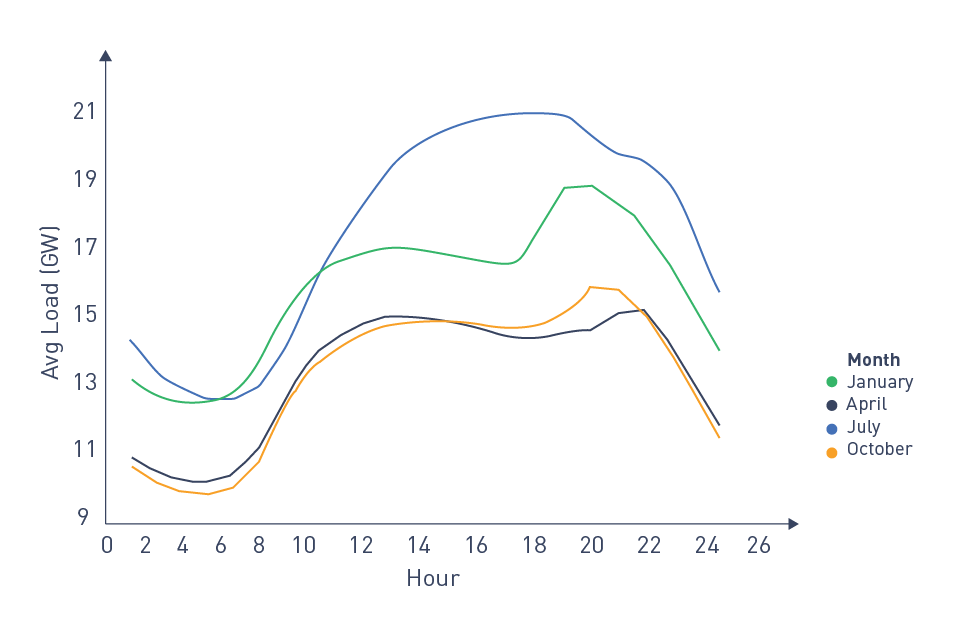Demand
In electrical power systems, demand refers to the total amount of electricity users need at any moment.
Base load is the minimal amount of power consumption that is constantly required throughout a given time period, which is generally 24 hours. This baseline level of demand is essentially constant regardless of time of day or night, and is fulfilled by power plants that work continuously to offer a consistent and reliable supply of energy.
Peak load refers to the highest level of electricity demand for a given time period. This period is often associated with peak energy use during the day, such as late afternoon and early evening, when residential, commercial, and industrial activity overlap.
The demand curve is a graph that shows how demand changes over time.

Figure 1: demand curve for different seasons
Effective demand management is critical for ensuring grid stability, maximizing usage of resources, and facilitating sustainable energy use.
Voltage
Power grids are designed to provide power to consumers at regularly stable voltages. This must be done despite fluctuations in demand, reactive loads, and even nonlinear loads. Furthermore, power is generated by generators and transmission and distribution equipment, which may not be entirely reliable. To keep voltage within the recommended range, grids frequently use tap changers on transformers near consumers to make needed adjustments.
Frequency
A synchronous grid is an electrical grid on a regional or larger scale that works with generators running at the same frequency and remains synchronized under standard system conditions. Synchronous grids make it easier to transmit power across large distances, allowing for more efficient electricity market trading and improved grid stability. These grids guarantee that all generators in the system operate at the same frequency and remain in phase with one another and the grid, allowing for balanced energy generation and use across the whole grid.
The system adapts in real time to changing load conditions in order to maintain a balance between power generation and consumption. When the load on the grid increases, the generators in the synchronous grid rotate more slowly, resulting in a minor dip in frequency. Conversely, as the demand drops, the generators speed faster, resulting in a tiny rise in frequency. This dynamic alteration of system frequency keeps the grid stable and the power supply matching demand, enabling for efficient and reliable energy transmission across the network.
Capacity
Capacity is the highest output that a power system can sustainably produce without exceeding its design limitations. It is commonly measured in megawatts (MW) and represents the total amount of electricity that generating units can deliver to the grid at any given moment.
Installed Capacity: Represents the overall capacity of all generators installed in a system, regardless of whether they are operating at any time.
Available Capacity: The quantity of electricity that can be generated at any one time, taking into account the equipment's operating state and continuous maintenance actions.
Firm Capacity
Firm capacity is a subset of total capacity that represents the amount of electricity that can be generated consistently at all times, even under bad conditions. It excludes any intermittent or unstable power sources, such as renewable energy sources that are weather-dependent.
Importance of Firm Capacity: Firm capacity is critical to grid reliability, particularly in areas with large fluctuation in generation or demand. It is used to ensure that there is always enough electricity to meet minimum demand levels, hence maintaining the power system's stability and minimizing blackouts.

直接登录
创建新帐号